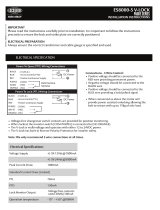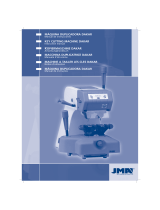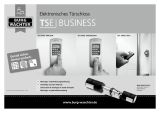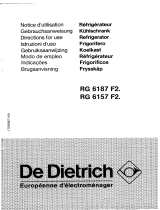
Gebrauchsanleitung
Mode d’emploi
Instructions for use
ASSA ABLOY (Schweiz) AG
Untere Schwandenstrasse 22
CH - 8805 Richterswil
www.assaabloy.ch
Für den Einbau von Profilzylindern ist zunächst die Schliessnase (Nocken) mit dem Schlüssel auf 0-Stellung
(6.00 Uhr) zu bringen. Ausfräsung des Türblattes, Einsteckschlosses und Schilder bzw. Rosetten müssen so
ausgerichtet sein, dass der Zylinder ohne Werkzeug spannungsfrei eingebaut und mit der Stulpschraube befe-
stigt werden kann.
Pour l’installation de cylindres profilés, il faut d’abord positionner avec la clé le panneton en position 0 (6
heures). L’entaille dans le vantail de la porte, la serrure, les garnitures de sécurité ou les rosaces doivent être
montés sans contrainte de manière à ce que le cylindre puisse être installé sans outillage et être fixé avec la
vis fournie.
When installing profile cylinders, firstly use the key to set the locking cam to the 0 position (6 o’clock).
Countersinking in the door panel and the installation of the mortise lock and plate or bezel must allow the
cylinder to be freely installed without the need for tools and fastened with the face plate screw.
Die Zylinderlänge ist so zu bemessen, dass der Zylinder (zumindest bei Aussentüren) aussen bündig mit dem
Beschlag bzw. mit der Rosette abschliesst. Bei Aussentüren werden zum Schutz des Zylinders dringend
Sicherheitsbeschläge empfohlen.
La longueur du cylindre est à mesurer de manière à ce que la partie extérieure du cylindre de sécurité (du
moins pour les portes extérieures) soit à fleur avec la garniture ou la rosace. Pour la protection du cylindre à
I’extérieur, il est vivement conseillé d’utiliser des garnitures de sécurité.
The length of the cylinder shall be measured such that the exterior of the cylinder lock (at least on outside
doors) is flush with the fitting or bezel. To protect the cylinder on outside doors, the use of security fittings is
strongly recommended.
Zylinder mit Prioritätenfunktion sind auf der entsprechenden Zylinderseite mit der Bezeichnung «Priorität»
versehen. Diese so bezeichnete Zylinderseite ist zur Türaussenseite zu montieren.
Bei innen steckendem Schlüssel kann der Zylinder von aussen mit dem Normalschlüssel geschlossen resp.
geöffnet werden. Ein aussen steckender Schlüssel lässt keine Schliessfunktion von innen zu.
Les cylindres avec fonction prioritaire sont gravés (priorité) sur le côté concerné du cylindre. Ce côté du
cylindre doit être monté à l’extérieur de la porte.
La porte peut être ouverte ou fermée depuis l’extérieur alors qu’une clé reste introduite du côté intérieur.
Toutefois, elle ne peut pas être fermée de l’intérieur si une clé reste introduite du côté extérieur de la porte.
Cylinders with priority functions are identified with a sticker (priority) on the corresponding side of the
cylinder. This side of the cylinder must be mounted on the outside of the door.
The door can be locked or unlocked from the outside with a key in the lock on the inside. However, it cannot
be locked from the inside if a key has been left in the lock on the outside of the door.
Ob Aufbohrschutz (ABS) oder/und Kernziehschutz, diese spezielle Ausführungsart erkennen Sie an der
Schlüsselkanal-Ansen kung. Diese so bezeichnete Zylinderseite ist zur Türaussenseite (Angriffseite) hin zu
montieren.
Le cylindre muni d’une protection contre le perçage ABS et/ou contre I’arrachage est reconnaissable grâce au
fraisage spécial du canal de clé. Ce côté du cylindre est à monter à l’extérieur de la porte, où une effraction est
possible.
Special cylinder types providing ABS protection (anti-drilling) and/or protection against core removal can be
recognised from the keyway countersinking. This side of the cylinder is to be mounted on the outside of the
door (the side of a possible break-in).
Der KESO-Profilzylinder, wie Art. 21.228, 21.239, 21.240 usw., mit Kernziehschutz sowie hochwertigem
Aufbohrschutz verfügt über einen Querstift als zusätzliche Verankerung am Sicherheitsbeschlag.
Le cylindre profilé KESO, articles numéros 21.228, 21.239 et 21.240, avec protection anti-perçage et
protection contre l’arrachage du rotor, dispose d’une goupille transversale pour un ancrage supplémentaire
dans la garniture de sécurité.
KESO profiled cylinders, articles numbers 21.228, 21.239 and 21.240, providing protection against both core
removal and drilling, has a cross pin for additional fastening to the security fitting.
Beim Einbau des Schliesszylinders ist zu beachten, dass sich der Querstift einwandfrei auf der Innenseite des
Sicherheitsbeschlages abstützt (Schutz gegen Durchstossen und Zylinderziehen).
Pendant le montage du cylindre, veillez à ce que la goupille transversale soit correctement positionnée en
butée sur le côté intérieur de la garniture de sécurité (protection contre le chasse-goupille et I’arrachage du
cylindre).
When fitting the cylinder, make sure that the cross pin is correctly positioned up against the inside of the
security fitting (protection against drift punches and cylinder extraction).
max. 3 mm
Profil mit Querstift
Profil avec goupille transversale
Profile with cross pin

Sie haben einen KESO-Sicherheits-Zylinder
erworben. Damit eine lange, reklamations-
freie Nutzung gewährleistet ist, bitten wir um
Beachtung folgender Hinweise und Informa-
tionen. Gemäss der im «Produkthaftungsge-
setz» definierten Haftung des Herstellers für
seine Produkte sind diese Informationen und
Hinweise zu beachten. Die Nichtbeachtung
durch Händler, Verarbeiter oder Endbenutzer
entbindet KESO von der Haftpflicht.
1. Die Zylinderlänge ist so zu bemessen, dass
der KESO-Schliesszylinder aussen bündig mit
dem Beschlag bzw. mit der Rosette abschliesst.
Bei Aussentüren werden zum Schutz des Zylin-
ders dringend Sicherheitsbeschläge empfohlen.
Zylinderschutz durch EH-Türschild
Profilzylinder ohne ABS und ohne Ziehschutz
– Klasse A
An einbruchgefährdeten Türen ist der
Profilzylinder mit einem VdS-anerkannten
einbruchhemmenden Türschild mit Ziehschutz
der Klasse A zu schützen. Derartige Türschilder
entsprechen der DIN 18 257 Klasse ES 1 - LA.
Profilzylinder mit ABS und mit Ziehschutz –
Klasse B
An einbruchgefährdeten Türen ist der Profilzy-
linder mit einem VdS-anerkannten einbruch-
hemmenden Türschild der Klasse B oder C zu
schützen. Derartige Türschilder entsprechen
der DIN 18 257 Klasse ES 2 bzw. ES 3.
2. Für den Einbau von Profilzylindern ist
zunächst die Schliessnase (Nocken) mit
dem Schlüssel auf 0-Stellung (6.00 Uhr) zu
bringen. Ausfräsung des Türblattes, Einsteck-
schlosses und Schilder bzw. Rosetten müssen
so ausgerichtet sein, dass der Zylinder ohne
Werkzeug spannungsfrei eingebaut und mit der
Stulpschraube befestigt werden kann.
3. KESO-Schliesszylinder sind Präzisionser-
zeugnisse. Sie sind von Fett, Öl oder Graphit
freizuhalten und nicht mit Farbe oder Lack in
Kontakt zu bringen. Als Pflegemittel empfeh-
len wir KESO-Mehrzweckspray (G.992/56/10).
Bei KESO-Change-Code-Zylindern niemals
Pflege-/Schmiermittel verwenden. Beim Bau-
tenzylinder darf erst NACH der Umstellung
Pflege-/Schmiermittel eingesetzt werden.
4. Treten Funktionsstörungen auf, so ist
zunächst zu prüfen, ob Beschädigungen am
Zylinder oder Fremdkörper im Schlüsselkanal
vorhanden sind (Fremdeinwirkungen) oder ob
der Schlüssel defekt ist. Wenn bei ausgebautem
Zylinder die Schlüssel einwandfrei eingesteckt,
abgezogen und auch gedreht werden können,
so liegt der Fehler anderswo (schlechte Zylin-
derlage im Schlosskasten, defektes Einsteck-
schloss, ungenau montierte Schliessbleche,
verzogene Türen usw.).
5. Die Produktleistungen sind in unseren
Katalogen, Prospekten, Leistungsbeschrei-
bungen konkret festgelegt oder sind mit uns im
Einzelfall zu vereinbaren. Richtungsweisend für
die sicherheitstechnischen und konstruktiven
Anforderungen an KESO-Schliesszylinder sind
die EN-Normen, insbesondere die EN 1303 und
VdS-Richtlinien.
6. Für Feucht- oder Kühlräume, bei direkter Be-
witterung, in Meeresnähe oder für den Einsatz
in aggressiver, korrosionsfördernder Umgebung
müssen Schliesszylinder entsprechenden Korro-
sionsschutz aufweisen.
7. Zur Erfüllung der Informations- und Instrukti-
onspflichten nach dem Produkthaftungsgesetz
stehen den Fachhändlern, Architekten, Planern,
Verarbeitern folgende Unterlagen zur Verfü-
gung: Kataloge, Prospekte, Ausschreibungstexte,
Angebotsunterlagen und insbesondere die
Gebrauchs-, Einbau- und Pflegeanleitung. Sie
sind gehalten, diese Produktinformationen zu
beachten und an die Benutzer weiterzugeben.
8. Bei neuen registrierten/patentrechtlich
geschützten Schliessungen/Schliessanlagen
erhält der Käufer eine Securitycard, bzw. in der
Schweiz eine e-Securitycard. Nachbestellungen
von Schlüsseln oder von KESO-Schliesszylindern
mit Schlüsseln zu diesen registrierten Schlies-
sungen/Schliessanlagen werden vom Händler
nur ausgeführt, wenn eine der beiden Karten
vorgelegt werden kann. Die Securitycard/e-
Securitycard ist deshalb sorgfältig aufzubewah-
ren und bei Eigentumswechsel der Schliessung/
Schliessanlage dem Erwerber zu übergeben. Bei
Verlust der Securitycard/e-Securitycard wird
nur dann ein Duplikat ausgestellt, wenn der
Nachbesteller eindeutig den Beweis des recht-
mässigen Besitzers der Schliessung/Schliessan-
lage nachweisen kann.
Vous venez d’acquérir un cylindre de sécurité
KESO. Pour assurer une longue utilisation sans
réclamations, nous vous demandons d’observer
les conseils et informations suivants. Conformé-
ment aux textes de la loi sur la responsabilité
des produits, le fabricant est tenu de respecter
ces informations et consignes. Le non respect
par le revendeur, l’installateur ou I’utilisateur
final n’engage pas la responsabilité de KESO.
1 . La Iongueur du cylindre est à mesurer de
manière à ce que la partie extérieure du
cylindre soit a fleur avec la serrure ou la rosace.
Pour la protection du cylindre à l’extérieur, iI est
vivement conseillé d’utiliser des garnitures
de sécurité.
Protection du cylindre par une garniture de
sécurite de porte EH
Cylindre profilé sans protection anti-perçage
(ABS) et sans protection anti-arrachage –
classe A
Sur les portes exposées à l’effraction, le cylindre
profilé doit être protégé au moyen d’une
garniture de sécurité agréé par VdS de classe A.
Ces garnitures de sécurité sont conformes à la
norme DIN 18 257 classe ES 1- LA.
Cylindre profilé avec protection anti-perçage
(ABS) et avec protection anti-arrachage –
classe B
Sur les portes exposées à I’effraction, le cylindre
profilé doit être protégé au moyen d’une
garniture de sécurité agréé par VdS de classe B
ou C. Ces garnitures de sécurité de porte sont
conformes à la norme DIN 1 8 257 classe ES 2
ou ES 3.
2. Pour I’installation de cylindres profilés, il faut
d’abord positionner avec la clé le panneton en
position 0 (6 heures). La serrure, les garnitures
de sécurité ou les rosaces doivent être montés
soigneusement de manière à ce que le cylindre
puisse être installé sans outillage et être fixé
avec la vis fournie.
3. Les cylindres KESO sont des produits de
précision. Ne pas appliquer de la graisse,
de l’huile ou du graphite, ne pas entrer en
contact avec de la peinture ou du vernis.
Nous conseillons le produit d’entretien multi-
usage KESO spray (G.992/56/10). N’appliquez
en aucun cas du lubrifiant/produit d’entretien
sur les cylindres Change Code. En ce qui
concerne les cylindres avec fonction passe
de chantier, veuillez appliquer du lubrifiant/
produit d’entretien UNIQUEMENT APRES
l’annulation de la clé passe de chantier.
4. En cas de défauts de fonctionnement, vérifiez
d’abord si le cylindre n’est pas endommagé ou
si le canal de la clé n’est pas obstrué (tentative
d’effraction) ou si la clé est défectueuse. Lors-
que le cylindre est démonté, que la clé tourne
sans effort et rentre et ressort parfaitement du
cylindre, le défaut se situe à un autre niveau
(mauvaise position du cylindre dans la porte,
serrure défectueuse, garnitures de sécurité mal
montées, porte faussée, etc...)
5. Les performances de nos produits sont décrites
dans nos catalogues, prospectus de descriptions
de produits ou sont a définir avec nous pour des
cas spéciaux. Les cylindres KESO sont fabriqués
en termes de techniques de sécurité et de
construction selon les normes EN, particuIière
-
ment la norme EN 1303 et les directives VdS.
6. En cas d’utilisation dans des pièces humides,
des chambres froides, à I’extérieur ou au bord
de la mer, les cylindres doivent être protégés
contre la corrosion.
7. Pour satisfaire aux obligations d’information
et d’instruction selon la loi sur la responsabi
-
lité des produits, les revendeurs, architectes,
maîtres d’état et maîtres d’ouvrage disposent de
la documentation suivante: les catalogues, Ies
prospectus, les textes de soumission, les offres et
tout particulièrement le manuel d’utilisation, le
manuel de montage et d‘entretien. Vous êtes te
-
nus de respecter les informations sur les produits
et de les transmettre à l’utilisateur.
8. Pour les nouvelles fermetures ou installations
de fermeture enregistrées ou protégées par bre-
vet, l’acheteur reçoit une Securitycard, ou une
e-Securitycard en Suisse. Les commandes sup-
plémentaires de clés ou de cylindres KESO avec
clés pour ces fermetures ou installations de
fermeture enregistrées, ne seront exécutées par
le revendeur que si l’une des deux cartes peut
être présentée. La Securitycard ou l’e-Security-
card doit donc être conservée avec soin et
remise au nouveau propriétaire en cas de vente
de l’installation de fermeture. En cas de perte
de la Securitycard ou de l’e-Securitycard, un
duplicata ne sera délivré que si le demandeur
peut fournir la preuve qu’il est le propriétaire
légal de l’installation de fermeture.
You have just purchased a KESO security
cylinder. To ensure long, troublefree use, please
observe the following recommendations and
information. In accordance with legislation
on manufacturers’ liability regarding their
products, these recommendations and infor-
mation must be adhered to. KESO shall not be
responsible should the retailer, installer or end
user fail to comply herewith.
1 . The length of the cylinder shall be measured
such that the exterior of the cylinder lock is
flush with the fitting or bezel. To protect the
cylinder on outside doors, the use of security
fittings is strongly recommended.
Cylinder protection with EH-escutcheon
Profile cylinder without drilling protection
(ABS) and without pull-out protection – Class A
On doors subject to break-in, the profile
cylinder should be protected with a Class A,
VdS-approved break-in prevention escutcheon
with pull-out protection. Escutcheons of this
kind comply with DIN 18 257 Class ES 1 - LA.
Profile cylinder with drilling protection (ABS)
and with pull-out protection – Class B
On doors subject to break-in, the profile
cylinder should be protected with a Class B or C,
VdS-approved break-in prevention escutcheon.
Escutcheons of this kind comply with DIN 18
257 Class ES 2 or ES 3.
2. When installing profile cylinders, firstly use
the key to set the locking cam to the 0 position
(6 o’clock). Countersinking in the door panel
and the installation of the mortise lock and
plate or bezel must allow the cylinder to be
freely installed without the need for tools and
fastened with the face plate screw.
3. KESO lock cylinders are precision products.
Do not apply grease, oil or graphite and keep
free from paint and varnish. We recommend
using KESO multipurpose spray cleander
(G.992/56/10). Do not use the KESO Spray for
Euro Change Code cylinders because of the
fact that the spray will damage and glue the
Change Code function. For building cylinders
the use of the KESO spray is allowed after the
change to the final locking.
4. In the event of a malfunction, check first of
all whether the cylinder has been damaged or if
the keyhole is blocked (attempted break-in) or
if the key is faulty. With the cylinder off the door,
if the key rotates effortlessly and can be easily
inserted and removed, the fault lies elsewhere
(incorrect cylinder position in the door, faulty
mortise lock, badly fitted protective plates,
warped door, etc.).
5. The performance specifications of our
products are described in our catalogues,
brochures and product descriptions or are to
be defined with us for special cases. KESO lock
cylinders are manufactured in terms of security
and construction techniques according to
EN standards, particularly EN 1303 and EN
directives.
6. When used in damp rooms, cold storage
chambers, outside or in coastal areas, the cylin-
der locks must be protected against corrosion.
7. To comply with information and instruction
obligations in accordance with the product lia-
bility laws, retailers, architects, contractors and
building owners are provided with the following
documentation: Catalogues, brochures, notices
of invitations to tender, tender documentation
and particularly instructions for use, installation
and maintenance. You must comply with this
product information and transmit it to the user.
8. The purchaser of new registered/patent-
protected locks/lock systems will receive one
Securitycard, in Switzerland one e-Securitycard.
Subsequent key orders or orders for KESO
lock cylinders with keys for these registered
locks/lock systems will only be fulfilled by
dealers when one of these two card types are
pre sented. Therefore the Securitycard/e or
Securitycard is to be carefully safeguarded and,
in the event of a change of lock/lock system
ownership, passed on to the new owner. If the
Securitycard/e or Securitycard is lost, a
duplicate will only then be issued when the
person placing the reorder is able to show
positive proof of legal ownership of the lock
or lock system.
ASSA ABLOY (Schweiz) AG
Untere Schwandenstrasse 22
CH - 8805 Richterswil
www.assaabloy.ch
BA.01.013/INT/V3.0
-
 1
1
-
 2
2
dans d''autres langues
- English: Assa Abloy Keso Operating instructions
- Deutsch: Assa Abloy Keso Bedienungsanleitung
Documents connexes
Autres documents
-
 LOCKWOOD (ASSA ABLOY) ES8000-1 Technical Manual
LOCKWOOD (ASSA ABLOY) ES8000-1 Technical Manual
-
 JMA DAKAR Manuel utilisateur
JMA DAKAR Manuel utilisateur
-
Escali Digital Scale Manuel utilisateur
-
Bosch KIF2002 Manuel utilisateur
-
Abus HomeTec Pro CFA3000 Manuel utilisateur
-
Dometic DM100/DP100 Mode d'emploi
-
 BURG WATCHER TSE 6102 Le manuel du propriétaire
BURG WATCHER TSE 6102 Le manuel du propriétaire
-
 De Dietrich RG6187E5 Le manuel du propriétaire
De Dietrich RG6187E5 Le manuel du propriétaire





